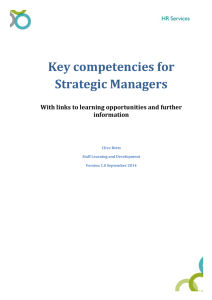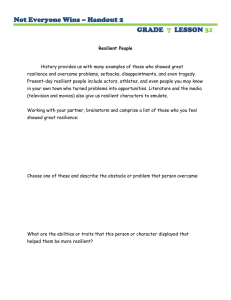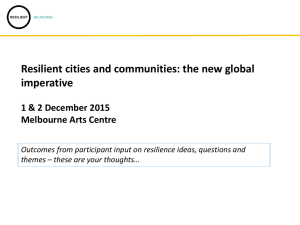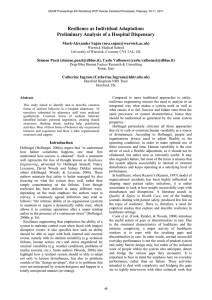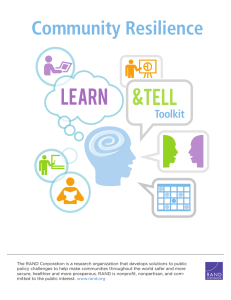Increasing individual resilience within the work place - the practicalities
advertisement
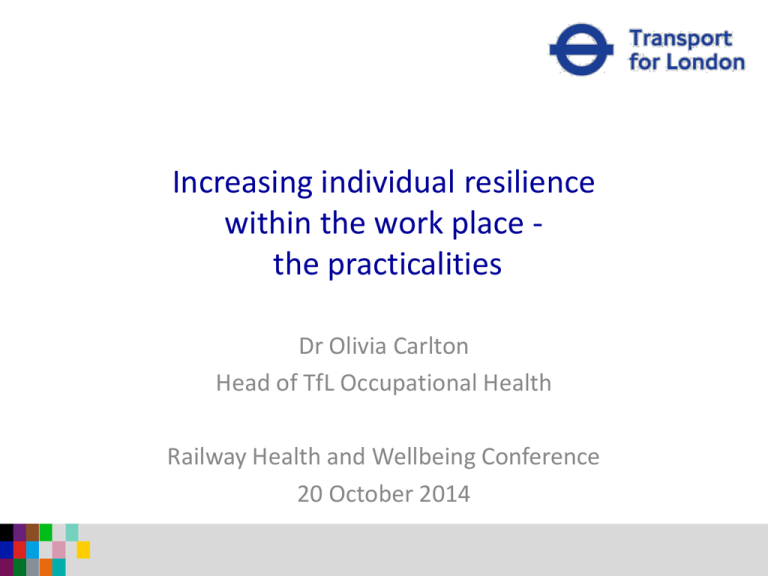
Increasing individual resilience within the work place the practicalities Dr Olivia Carlton Head of TfL Occupational Health Railway Health and Wellbeing Conference 20 October 2014 What is resilience? Speedy recovery from problems Ability to recover quickly from setbacks Ability to react to potential crisis To identify, assess and respond to potential disruptive situations and prevent it becoming a crisis. Elasticity of matter Ability to spring back into shape after being bent or stretched Definitions from Oxford English Dictionary 2 How to increase resilience in the workplace • Individual – – – – Learn about it Develop self-awareness Desire to change to become more resilient Learn and practise small changes • Line manager – – – – – As for individual Understands themselves and their impact on their people Wants to behave in a way that allows their people to flourish Has time to reflect! Actively manages good and poor performance • Environment – – – – People respected and treated with dignity Policies that are fair Processes for people management that are timely Resilient culture – allows recovery after effort 3 Practicalities • Need a common language – People must be talking about resilience • Works best (some would say it only truly works) if there is high level buy-in and leadership, not only in words but in behaviours • Need some methods to encourage behaviour change • Need to be able to measure where you are as a company • Need a systems approach • Various ways to achieve these 4 The TfL approach slide 1 • Co-ordinated by mental health lead for the company • Individuals – E-learning for individuals – uses self assessment – Seminars and workshops are available • Managers – Incorporate into people management training (still working on this one – making progress) – Workshops for managers – “Hot spot” work – Use a part of regular management meetings to reflect (best practice – this happens with some groups of managers) 5 The TfL approach slide 2 • Health Fairs • Policies and procedures – Aim to be fair and timely • Culture – increasing focus on behaviours • Measures – though employee surveys – Trialling a “pulse” survey 6 What affects resilience – the individual ©EJT Associates SUPPORTIVE THINKING INNER BUOYANCY APPLICATION RESILIENCE COMMUNITY AND NETWORKS POSITIVE LIVING SELF CONTROL 7 Power of self assessment • A simple self-assessment questionnaire (© EJT Associates) – – – – – – – – Four questions for each domain of the model Score each question 0 – 10 Gives an overall score Looking for a balance across the domains Most people score much more highly in some than others Focus on the low scoring areas Very simple to understand Revisit it as often as the person wants to • Encourages self-reflection 8 What helps managers • Common language • Time for reflection – Self as resilient – Provides a model for the team – Small changes to culture; o Shared lunch once a month o Walk once a week • Involvement of their peers – Eg 10 minutes at a regular managers meeting to reflect together on progress 9 Conclusion To increase individual resilience we need an organisational, systems approach Good luck! 10 Questions? olivia.carlton@tube.tfl.gov.uk 11

